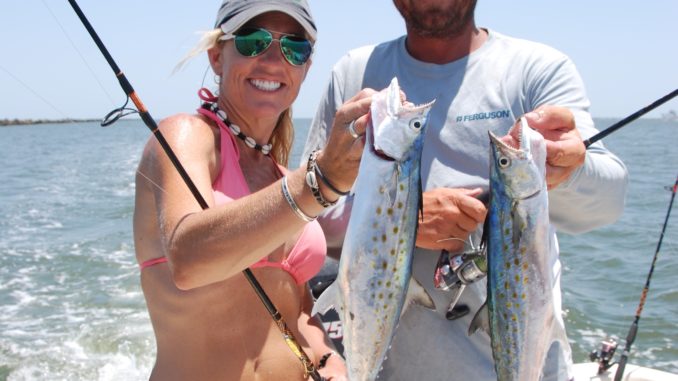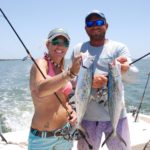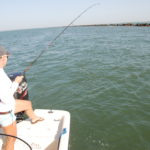
You don’t have to speak Spanish to put the smackdown on plenty of Spanish mackerel in South Carolina waters.
One of the surest signs of summer along the South Carolina coast is when droves of Spanish mackerel show up in the nearshore and coastal waters. In reality, these fish start showing up as early as late April when migrating up from the south.
Guide John Koonce of Shoal Bandit Charters said anglers can expect to start catching them in good numbers in the waters around Charleston in May, and the Spanish seem to get bigger and thicker as summer progresses before heading back south sometime around November.
Koonce said during the middle of summer, Spanish will still travel around a good bit, but they’re just following baitfish, so getting on them means doing a bit of searching at the start of each trip.
“One day, they will be stacked up along the North Jetty, and the next they will be across the harbor on the South Jetty,” Koonce said. “One of the best ways I use for locating them is by trolling up and down the jetties and watching for signs of them feeding on baitfish.”
Koonce likes to start out by trolling to the jetties that outline the entrance to Charleston Harbor, not only to give clients a chance to see a lot of scenery, but he can do a visual check on everything else that might be biting.
“Trolling for Spanish is a good way to start off,” he said. “You can watch the rocks, and you can cover all that water, and then you start seeing different schools of bait or maybe you’ll see something out of the ordinary like a school of something else and say, ‘Man, I really want to go fish that right there.’ It’s so easy just to stop and then set up on.”
For Koonce and his clients, the appeal of fishing for Spanish is multifold. The fish bite hard and fast, and they make for delicious table fare.
“I think fishing for Spanish mackerel is somewhat of an untapped resource since they’re so good to eat and they’re so much fun to catch,” he said. “A lot of people will see birds diving and everything, and they don’t know why. Most times, it’s a little school of minnows, and the Spanish will be in there feeding on them. You’ll see them skyrocket through the bait and shoot 3 or 4 feet into the air.”
Koonce said Spanish mackerel will normally be feeding on small glass minnows, one of the main species of baitfish that show up along the coast. Koonce has two different approaches: troll until he finds Spanish, then stop and cast to them, or troll until he starts catching them, then concentrate on trolling that immediate area.
A big factor in successful trolling for is water clarity, Koonce said, because Spanish feed primarily by sight. Having calm, clear water helps them when hunting baitfish.
The water will typically be clearer on an incoming tide, but that’s not a hard and fast rule, and it’s one reason why he swaps between the North Jetty and South Jetty on different stages of the tide because the rock structures are affected differently by the current, and one side will be usually clearer and calmer than the other.
“The glass minnows like to tuck back in the calmer water on the downwind or downcurrent side of the jetties,” he said.
Koonce trolls with medium-action tackle, 10-pound test, and he will rig a ½- to 3/4-ounce egg sinker about 2 feet out in front of the bait when he trolls. He trolls Diamond Jigs and Clark Spoons, and if he decides to stop and cast, he’ll cast the same rigs, retrieving them as fast as possible through the school, with no delays.
“I sometimes wonder how these fish can hit a bait so hard that’s moving that fast and never get the hook,” he said. “I’ve tried rigging stingers and trailer hooks, but it seems like when they’re hungry, they will stay on and when you’re just getting reaction bites, just expect about half of the fish to come loose.”
Koonce has also had success catching bigger Spanish mackerel using a small menhaden under a popping cork that he casts into a school.
“We did that a couple days ago, and a 25-pound king (mackerel) came tearing through and hit the bait,” Koonce said. “Nobody seemed to mind.”
An hour or so north of Charleston, targeting big Spanish mackerel with live bait is the specialty of J Baisch of Fishful Thinking Guide Service, who runs out of Murrells Inlet and heads to nearshore artificial reefs for Spanish.
Baisch said that trolling works as well along the Grand Strand as anywhere else, but he has found he can catch bigger fish by keeping his boat stationary and bringing the fish to him by chumming with live bait.
“Early July is when the mullet get big enough to cast-net,” he said. “What I do is fill up my livewell with 500 or 600 live mullet, then go anchor out over an artificial reef. I start letting the mullet go two or three at a time around the boat and keep a short piece of wire with a No. 2 or No. 4 treble hook and a mullet hooked in the back, ready to cast.”
Baisch said the key is throwing the mullet far enough away from the boat so they don’t turn back to the boat and hide. He said mullet don’t dive to hide, and the presence of baitfish finning at the surface will bring Spanish off the reefs and wrecks and to the surface in a hurry.
Baisch said there is a fine line chumming between attracting the trophy gamefish you’re seeking and chumming for anything in the area.
“Chum is like a woman. The one that’s easy to get is going to bring sharks,” Baisch said. “The one that plays hard to get is going to bring gamefish. When you chum, chum sparingly. Play hard to get. That’s how you get the good game fish.”
So why chum at all? If less is more, why not just cast out a live mullet carrying a hook? Baisch said the secret to chumming with live mullet is to get the big Spanish excited so they make a mistake.
“If I was just casting out, working these mullet with a hook in the back, Spanish would come up and look at it all-day long but hardly any would eat it,” he said, referring to the fish’s keen eyesight and reluctance to eat a bait if they think about it too long. “When they’re chasing one without a hook in its back, they let down their guard for about 10 seconds, and that’s when you can cast one with a hook it its back right where they’re boiling, and you can get those big fish to make a mistake.”
DESTINATION INFORMATION
HOW TO GET THERE — Charleston is accessible from most places in South Carolina by I-26 and US 17. Popular ramps in the area include Remley’s Point on the Wando River in Mount Pleasant, on CR 56, just north of US 17; Shem Creek on Shem Creek in Mount Pleasant off SC 703, and Wappoo Cut on Wappoo Creek off SC 171 between West Ashley and James Island. Murrells Inlet is north of Charleston on US 17. The only public boat ramp is off US 17 Business next to Captain Dick’s Marina.
WHEN TO GO — Spanish Mackerel begin to arrive in the spring and will stay off the South Carolina coast and in large bays or inlets until late fall, when they migrate back south.
BEST TECHNIQUES — Three primary tactics include trolling, casting to schooling fish and live-baiting. Troll Clark Spoons or Diamond Jigs when searching for fish. Casting spoons and flies are productive when retrieved very quickly. Larger Spanish are frequently caught by fishing live-bait around structure. Chumming can help increase your success.
FISHING INFO/GUIDES — John Boy Koonce, Shoal Bandit Charters, Charleston, 843-425-2939, www.shoalbandit.com; J Baisch, Fishful Thinking Guide Service, Murrells Inlet, 843-902-00356, www.fishthinkguidesc.com. See also Guides and Charters in Classifieds.
ACCOMMODATIONS — Best Western Patriots Point, Mount Pleasant, 843-971-7070; LaQuinta Inn & Suites, Charleston, 843-556-5200. Charleston Convention Visitors Bureau, www.charlestoncvb.com; Visit Myrtle Beach, www.visitmyrtlebeach.com.
MAPS — Maps Unique, 910-458-9923, www.mapsunique.com; Sealake Fishing Guides, 800-411-0185, www.thegoodspots.com.







Be the first to comment